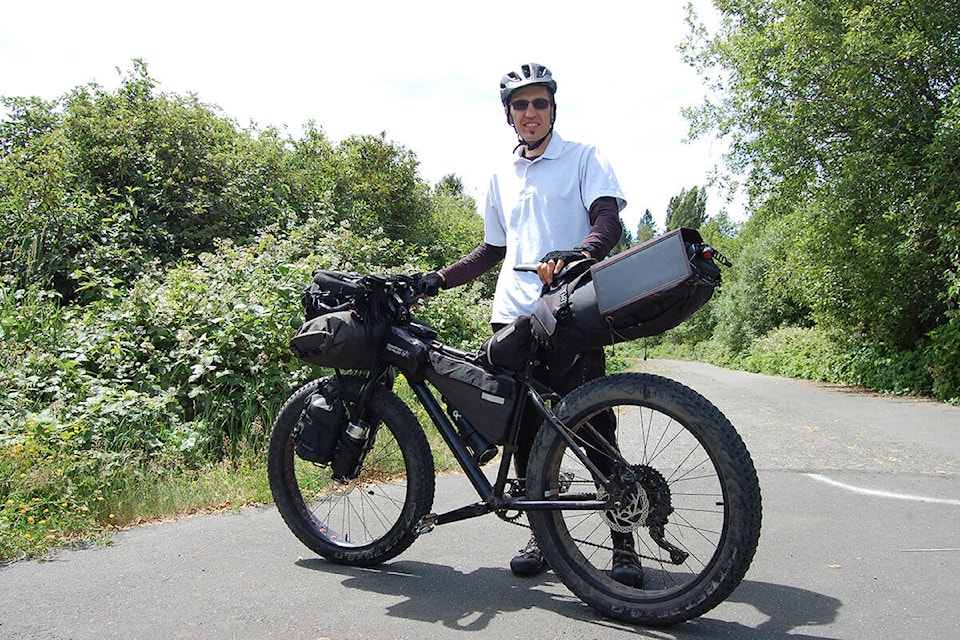Campbell River city council is looking at allowing vehicles back on the Elk River Timber (ERT) Trail (formerly Road) and scaling back pedestrian and bicyle use of the public trail.
The proposal is contained in the latest draft of the Master Transportation Plan (MTP) which is currently in the third and final stage of development. City council discussed the MTP at its Nov. 7 committee of the whole (COW) meeting but decided to defer it to a later date to allow councillors to study it further ahead of more in-depth discussion.
However, the inclusion of an item on the future of the ERT Road (as it is most commonly known, including in the draft MTP) has cycling enthusiasts alarmed about what city council plans to do with the decommissioned road.
The Stage 3 draft and final MTP contains the item about the ERT Road under “Streets and Connections” for discussion.
It says, “Explore the feasibility of reconstructing the ERT to accommodate vehicle traffic and a separated multi-use pathway from Evergreen Rd. to 14th Ave., as a north-south connection to accommodate future population growth in the Quinsam Heights neighbourhood with the life of this plan.”
That is a change from an earlier version of the MTP released during Phase 2, says John Elson, a member of the Cycling Advocacy Committee.
“There was no mention of ERT in the Phase 2 report,” Elson said. “Scaling back bike lanes is a missed opportunity; removing a green corridor that is well-used by runners, cyclists, hikers, dog walkers, etc., is vandalism. Once an amenity like this is lost, it can never be recovered.”
In the discussion about deferring the MTP on Nov. 7, councillors expressed discomfort with the concept of “active transportation” (cycling and other human-powered transportation) and felt that the draft plan pays far too much attention to cycling and not enough on other transportation issues.
“Throughout the last year, you know, we had the Dogwood report done, and we had a lot of negativity around the general topic of bike lanes and that still features quite prominently in here,” Coun. Ben Lanyon said.
Lanyon suggested that city should maybe be guided by public opinion on this and not what the city itself thinks is better.
Coun. Sean Smyth agreed too much emphasis is put on active transportation.
“I think one of the objections we got to the Dogwood corridor is kind of the friction between traffic congestion and bike lanes and active transportation,” Smyth said. “And I see this report as being very heavy on active transportation and light on congestion. So I think if we move ahead with this report we’re gonna see that friction again in the community.”
But Elson said council is being too shortsighted and would be closing the door on this issue for future consideration.
“There’s a consensus among urban planners that tomorrow’s cities need to be more densely populated, less dominated by cars and more accessible by foot, bicycle and transit,” Elson said. “This is how we limit GHG (greenhouse gas) emissions and create a healthier, more livable and more sustainable city.”
Elson said the MTP, commissioned at considerable expense and staff time, was “a sound attempt to move Campbell River in that direction.”
“It was not perfect – no mention of the ERT or of a safe way to cycle downtown, for instance – but contained some good guidelines for the next decade,” Elson said.
In gutting the MTP, council is ignoring the advice of experts and their own staff, Elson said.
“The Phase 2 report needs to be accepted by council in order for staff to have a long term plan to build a connected network of pedestrian and cycling routes,” he said. “The MTP is a 10-year project; this council need not pursue it during its term, but it’s a mistake to rob future councils of these valuable guidelines.”
Coun. Lanyon was also concerned about council being “distracted” by transportation when it should be focusing on the “top priority” of “downtown issues, homelessness, housing affordability an crime.”
“I think we might be mis-allocating in this present time, and we should shelf those sorts of thoughts until we solve our major priority. But I understand we were looking ahead, we will not spend the money now. But I think it signals to the community that we might be distracted from their top priority in some way,” he said.
Councillors had a number of concerns about the Phase 3 draft of the MTP, not just specifically with cycling. For example, there were concerns about whether the public, other levels of local government and First Nations had been adequately consulted.
“I have several concerns raised that I think need addressing, including where our priorities and our future visioning should be,” Coun. Susan Sinnot said. “But I think at the end of the day, having walked for hours along the proposed streets and routes and talk to people, that there’s significant improvements that we can suggest before we send it out to the public.”
Mayor Kermit Dahl reminded council that the item on the Nov. 7 COW agenda was for receipt and discussion and not for adoption. A motion to defer the MTP was carried with none opposed.
